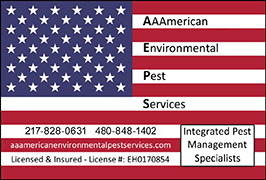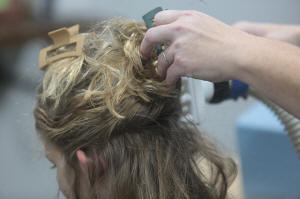Lice concerns rise as children return to school. Here's what parents can
do
[September 25, 2025]
By CHEYANNE MUMPHREY
Children have returned to school and are bringing home stories about the
things they learned and the friends they made. But some parents are
concerned they could also be bringing home a tiny nuisance — lice.
Though schools are not the only place transmission occurs, the Centers
for Disease Control and Prevention says head lice infestations in the
U.S. are most common among preschool and elementary-age children.
Since the middle of August when students began returning to school, more
people have searched Google for information about the blood-sucking
parasites and are seeking answers to common questions about how to
prevent and treat infestations, according to Google Trends. The CDC
estimates there are up to 12 million head lice infestations annually in
the U.S. infecting children between 3 to 11 years old.
Experts say there is a lot of misinformation about lice. Here are the
experts' answers to commonly asked questions:
How do you know if your child has lice?
Head lice are parasitic insects that feed on human blood, but they are
difficult to find because they are very small, move quickly and avoid
light. The hallmark symptom that indicates there might be an infestation
is new and onset itching of the scalp, said Dr. Danilo C. Del Campo, a
dermatologist in Chicago and a fellow of the American Academy of
Dermatology.

The eggs, commonly called nits, can be yellow, brown or tan and look
like tiny seeds, but when hatched will appear clear, experts say. An
infestation can often be confused with dandruff or seborrheic
dermatitis.
Becky Boudreau, a head lice technician in New Hampshire, says because
lice are most active at night, parents may notice their children
scratching more then or not sleeping well. She said it may take longer
to recognize a lice infestation in children who have a high pain
tolerance or are less reactive to insect bites.
There is no set number of lice that would classify as an infestation,
either you have lice, or you don't, experts say.
What are my treatment options?
Treatments to get rid of the insects include medication and specialists
who use different methods to manually remove the eggs and adult lice.
Depending on the age and temperament of the child, access to clinics or
technicians, the cost and the severity of the infestation, including any
sensitivities, will determine the most appropriate treatment option.
Many people hire nit pickers or visit clinics because they don't want to
handle the insects, Boudreau said.
“It is still successful, but it is time consuming,” said Boudreau, who
became a head lice technician about six years ago after her child had an
infestation.
Dr. Krista Lauer, national medical director for Lice Clinics of America,
says their clinics have become another option. They use an FDA-cleared
medical device that uses a combination of airflow temperature, speed and
direction to kill lice and their eggs. Technicians consider children's
heat sensitivity or restlessness, but for the treatment to be
successful, they must use the device in a specific pattern before
combing out the dead debris and using a washable topical substance, she
said.
Boudreau, who uses shampoo, olive oil and a special comb to assist in
combing out the insects, says many of the over-the-counter kits “are
designed to fail" and often require multiple uses for this reason.
Guidelines from the American Academy of Dermatology Association
recommend retreating for any product that can be bought without a
prescription, and that no approved method can kill lice and their eggs
during the first treatment.

[to top of second column]
|

Jacob Anthon demonstrates the use of an FDA-cleared device that uses
a combination of airflow temperature, speed, and direction to kill
lice and eggs at Lice Clinics of America in Sugar Land, Texas,
Monday, Sept. 22, 2025. (AP Photo/Lekan Oyekanmi)
 As long as people are using
products, like shampoos, as indicated on their labels they should be
OK, said Del Campo, who is board certified by the American Board of
Dermatology. He emphasized that many of these products have been
tested and approved by the Food and Drug Administration. Some of
those products include benzyl alcohol lotion which only kills lice
and not the eggs, ivermectin lotion, malathion lotion, and lindane
shampoo which can be toxic if used incorrectly.
But he said many dermatologists don’t jump to using the lice combs
or other procedure-based treatments because it often takes a lot of
time and energy for parents, requires multiple applications and is
not consistent across hair types. Instead, he said there are
“effective over-the-counter medications that require no
prescription, require no doctor guidance and are a wonderful first
step for parents.”
There is no scientific evidence that home remedies like smothering
hair with oil, mayonnaise or something occlusive can kill lice or
their eggs, experts say.
What can you do to manage an infestation?
Adult lice can live for about 30 days on their hosts' heads.
However, experts say they will die within two days if they fall off
a person and cannot feed. Their eggs can take up to nine days to
hatch and from there another seven days to mature into adult lice.
Lice cannot hop, jump or fly and are mostly spread through
head-to-head contact where the parasites can crawl from one host to
another, experts say.
The CDC suggests machine wash and dry clothing, don't use infected
hair products, furniture or toys, and clean where infested people
were. But their guidance also says it is less likely that lice could
be spread through used products.
“Most of the jobs I get called to are in my families’ homes and I
can’t get these bugs home quick enough from a job to take their
pictures or study them because they die so quickly without the heat
and blood from their hosts,” Boudreau said.

Can my child go to school with lice?
Students with head lice infestation do not need to be sent home
early from school, the CDC says. Students can go home at the end of
the day and return to class once beginning treatment. Experts say
successful treatments will kill crawling lice but that nits might
still be present.
Del Campo said parents need to be advocates for their children
because there are many outdated school policies forcing them to miss
more school than they need to, including requiring all eggs to be
removed before returning to class, which he says is not necessary.
“Lice are not dangerous. They don’t spread disease. There’s no
medical reason to remove a child immediately from a classroom,” he
said. “By the time lice are noticed, they've often been present for
weeks — not days or even hours."
He says it is likely that adults have some level of trauma from
dealing with lice when they were children and when there were fewer
effective treatments, and misconceptions about the parasites often
add to the stigma and accompanying embarrassment affected people
might feel.
“What people went through and are carrying with them is
understandably miserable, but it is very different today,” he said,
adding that lice are not associated with hygiene, disease or
economic status.
All contents © copyright 2025 Associated Press. All rights reserved |